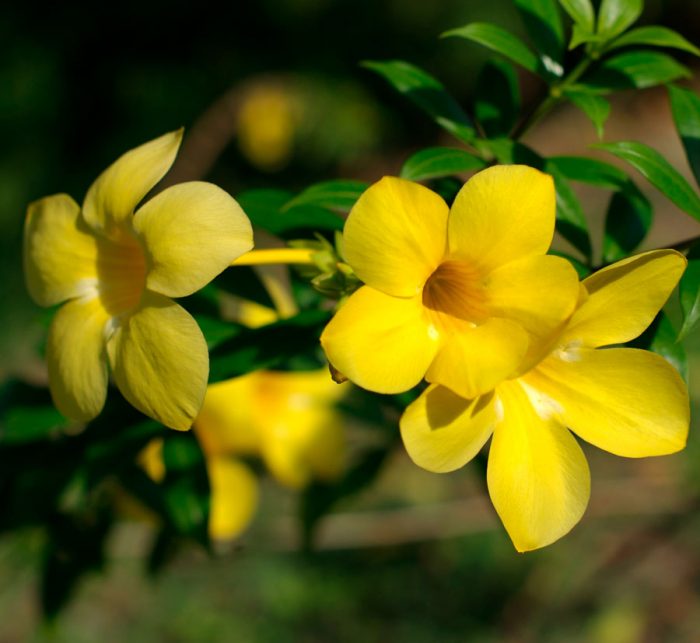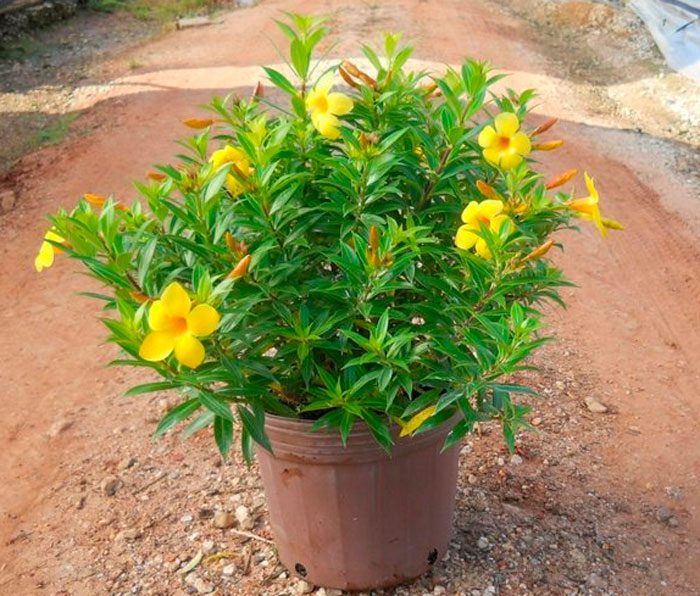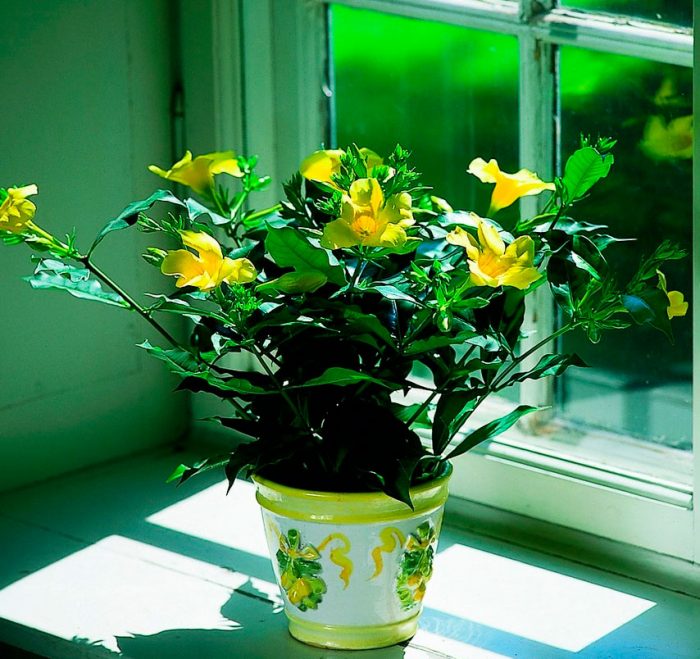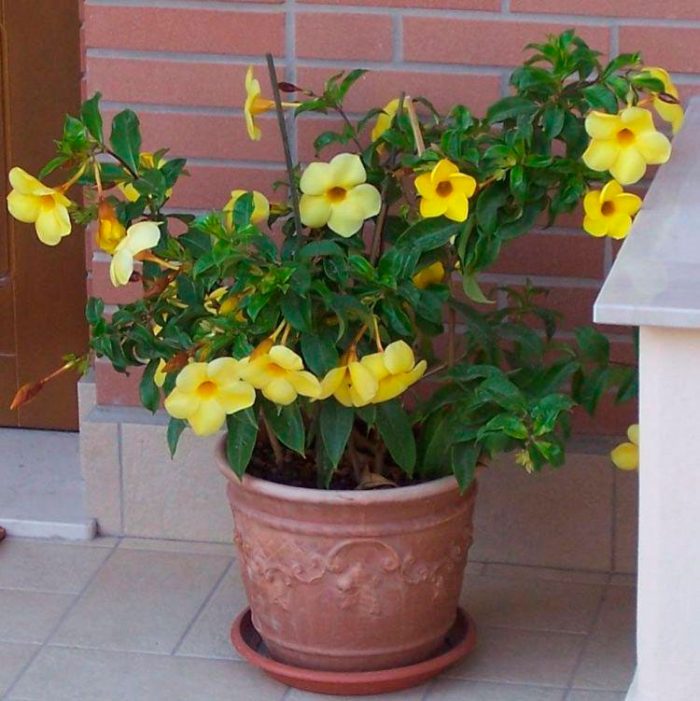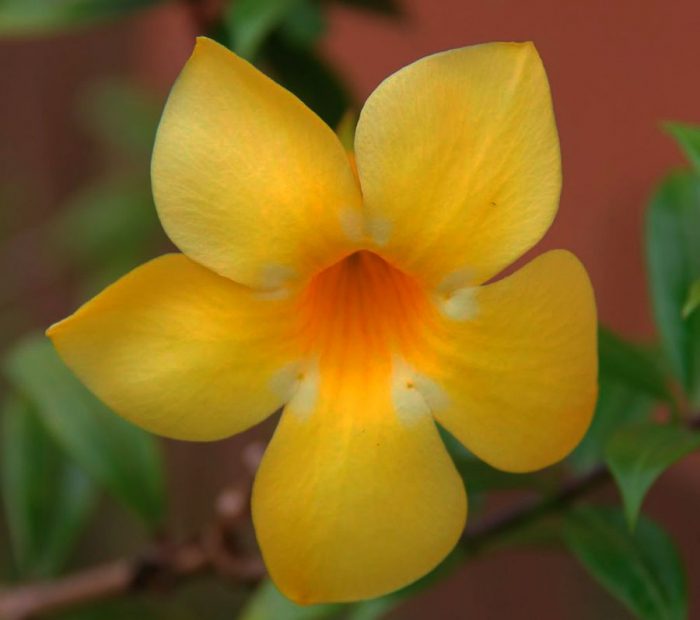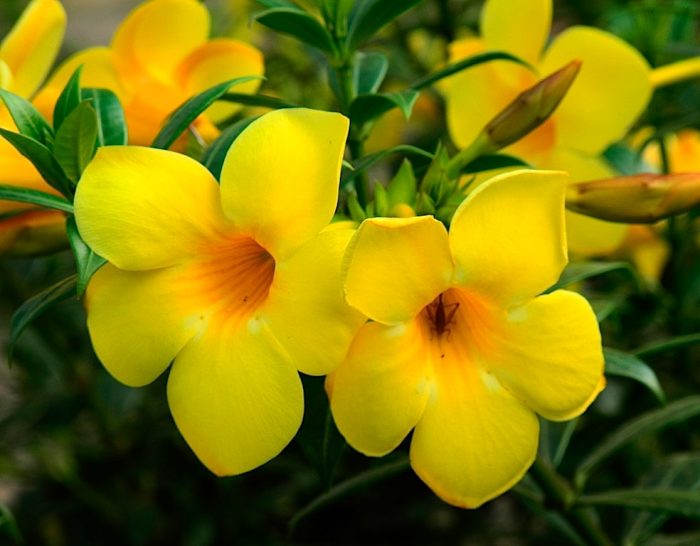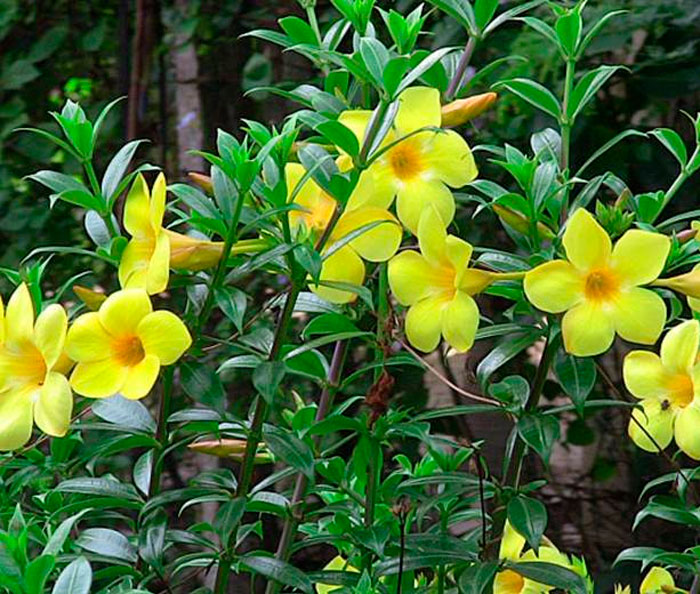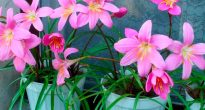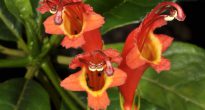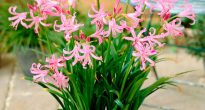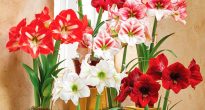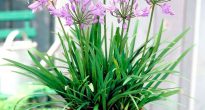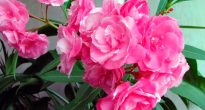The Allamanda plant is part of the Kutrovy family. And this genus unites about 15 different species, which are represented by evergreen shrubs and lianas. In nature, they can be found on the territory of America in tropical regions.
In room culture, allamanda is quite rare, since it is distinguished by demanding care, namely, to temperature, lighting and humidity levels. Also, the bush needs mandatory systematic pruning. If you grow it in a pot, then it also needs a reliable support. It is also recommended to replant Allamand regularly once a year.
Content
Brief description of cultivation
- Bloom... It is observed in May – September. However, indoor allamanda blooms only in conditions as close to natural as possible.
- Illumination... Needs lots of bright light.
- Temperature regime... In winter, from 15 to 17 degrees, and in summer - from 20 to 25 degrees.
- Watering... Water abundantly throughout the spring and summer period. With the onset of autumn, a gradual reduction of watering is carried out, and in the winter months it is carried out only when the surface of the substrate dries out in depth by about 30–40 mm.
- Air humidity... It should be elevated. To do this, the bush is systematically moistened from a sprayer, and it can also be placed on a pallet filled with wet pebbles or expanded clay.
- Fertilizer... Top dressing is carried out only during the period of active growth with a frequency of 1 time in 20 days, for this, organic matter and complex minerals are used. A dormant bush is not fed.
- Dormant period... It starts in late autumn and ends in early spring.
- Transfer... They spend it in the spring. While allamanda is young, it is transplanted systematically once a year, and older specimens only if necessary (on average, once every 2 or 3 years).
- Support... The bush needs support. It is placed in a pot during transplantation. To do this, you can choose a ladder or an arch.
- Soil mixture... Peat, sand, humus, leaf and sod soil (1: 1: 5: 2: 1).
- Pruning... At the very end of the period of intensive growth, all shoots should be shortened by ½ part. And during the growing season, all weak stems are systematically cut out.
- Reproduction... Practically lignified stem cuttings and seed method.
- Pests... Whiteflies, spider mites, nematodes and aphids.
- Diseases... Root and stem rot.
- Properties. The plant sap contains poison!
Allamandra care at home
Illumination
Experts advise choosing a bright place with lots of bright light for Allamanda. The southern window sill is best suited for it, while it should be borne in mind that the bush reacts well to a not very large amount of direct rays of the sun. This evergreen plant grows well in winter gardens as well as greenhouses.
Temperature regime
In spring and summer, the plant should be warm, the optimum temperature at this time is from 20 to 23 degrees. From the end of November to the end of February, the bush should be in a cooler place (from 15 to 17 degrees), while watering should be reduced. Protect him from drafts, as they can cause significant harm to him.
Watering
In summer, the flower should be watered regularly and abundantly. In no case do not allow the earthen coma to dry out or liquid stagnate in it. In winter, the substrate in the pot is moistened only after its top layer dries.
Air humidity
Since the plant needs high air humidity, during the period of active growth it will need to be regularly moistened from a sprayer. During the flowering period when the bush is moistened, make sure that droplets of moisture do not fall on the surface of the flowers, as this can negatively affect their decorative effect.
You can also increase the humidity level by pouring wet pebbles or expanded clay into a deep pallet, and placing a pot with a plant on top of it.
Top dressing
Indoor allamanda is fed only during the growing season, they do this once every 3 weeks. For this, both mineral complexes and organic matter are used. As for the concentration, it should be the same as indicated on the packaging by the manufacturer.
Pruning
For a more lush flowering in late autumn, the bush is pruned. The stems are shortened by ½ part of the length, while the cut is made above the leaf node. During the active growth of the bush, weakened stems are cut out in a timely manner. Since the shoots of such a plant can hardly be called powerful, they need support.
Allamanda transplant
The transplant is carried out at the end of flowering in the spring months. Young bushes grow very quickly, so they have to be replanted regularly once a year. With age, the frequency of transplants decreases to one in 2 or 3 years, and they are carried out only when it is really needed.
There are 2 options for a soil mixture suitable for growing allamanda:
- sod, leaf and humus soil, peat (1: 2: 1: 2), and a small amount of sand;
- leafy and soddy soil, humus, peat and sand (2: 1: 5: 1: 1).
Allamanda venom
Remember that allamanda juice contains a strong poison... In this regard, at the end of work with a flower, be sure to wash your hands well with soap and water. For example, the sap of a plant can get on the skin of the hands during a reproduction or transplant procedure.
Reproduction methods
Growing from seeds
For sowing seed, a soil mixture of sand and peat (1: 1) is used, which must first be moistened. The crops are covered with foil on top and removed to a warm (from 23 to 24 degrees) place. Ventilate them regularly, and if necessary, moisten the substrate with a spray bottle. The first shoots should appear on the surface of the substrate 3-6 weeks after sowing.
Cuttings
First, prepare the cuttings. To do this, cut off the almost lignified stems and divide them into pieces about ten centimeters long.For rooting, they are planted in moistened sand. In order for rooting to occur quickly, the lower part of the cuttings is treated with an agent that stimulates root growth, and also provides bottom heating. Cuttings need systematic spraying, as well as warmth (from 23 to 24 degrees).
After complete rooting of the segments, they are transplanted into separate containers, while using a substrate consisting of sod and humus soil, and also sand, which are taken in equal parts. After 1–1.5 months, the plants are given the same care as the adult bushes.
Possible problems
Allamanda rots
In some cases, the allamand has a blackening of the base of the stem, and then rot forms on it. This is due to the stagnation of moisture in the soil mixture or the thickening of the plantings during sowing. It can also lead to the development of a "black leg" on young plants.
Allamanda leaves turn yellow
With a lack of nutrients or with excessively poor lighting, the growth of the bush slows down, its shoots stretch out, flowering is more scarce, and the leaf plates may also turn yellow.
Allamanda leaves turn brown and curl
The leaf plates turn brown, and they also twist as a result of exposure to cold air or a draft. Excess moisture may also be the culprit. Reduce watering and monitor the room temperature.
Pests
Pests such as nematodes, spider mites, whiteflies and aphids most often settle on Allamand.
Types of allamanda with photos and names
Allamanda nobilis
This species has light red stems. Sitting lanceolate leaf plates have a pointed tip, and they reach about 20 centimeters in length. There is pubescence on the seamy surface of the foliage. Leaves grow from nodes in bunches of 2 or 3. The flowers with a pleasant smell reach 12 centimeters in diameter. They are colored yellow, with a speck of pale color in the pharynx.
Allamanda Hendersonii
This species is fast growing. It is decorated with comparatively thick, leathery to the touch leaf plates, which are collected in bunches of 3-4 pieces. In diameter, the orange-yellow flowers reach about 12 centimeters. There are 5 pale specks on the petals.
Allamanda grandiflora
This slow-growing species is often cultivated as an ampelous plant. The lanceolate-ovate plates are small. The bush blooms profusely. Lemon-yellow flowers reach 10 centimeters across.
Allamanda schottii
This vine is fast growing. On the surface of its stems there is pubescence, while the branches are warty. Lanceolate leaf plates grow in bunches of 3 or 4 pieces. Yellow flowers adorn stripes of brown shade, their throat is dark yellow.
Allamanda oleandrolist (Allamanda neriifolia)
Such a shrub with drooping stems reaches a height of about 100 cm. The short-peted leaf plates are up to 12 centimeters long, their shape is elliptical or pointed-lanceolate. The front surface of the foliage is dark green, and the back is a lighter shade. During flowering, yellow flowers form on long pedicels, the corolla tube of which is swollen at the base. The diameter of the flowers is about 40 mm.
Allamanda laxative (Allamanda cathartica)
This climbing plant is most popular with flower growers. The length of its stems can be up to 600 cm. Opposite large, elongated ovate leaf plates are almost completely naked (pubescence is present only on the seamy surface of the plate along the veins). The leaves are about 14 centimeters long and about 4 centimeters wide. Pale yellow funnel-shaped tubular large flowers form in the upper part of the stems, their diameter is about 60 mm, while the base is white.
Allamanda violet (Allamanda violacea)
This species is represented by a slow-growing climbing vine. The pubescent elliptical leaf plates are about 15 centimeters long, they are collected in bunches of 4 pieces. In the upper parts of the stems, pale purple flowers are formed, which are also collected in 2 or 3 pieces in bunches.

